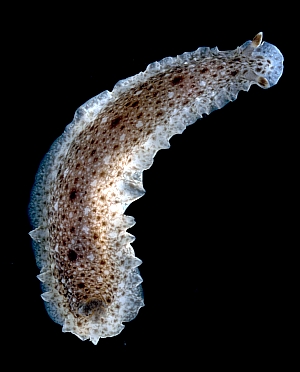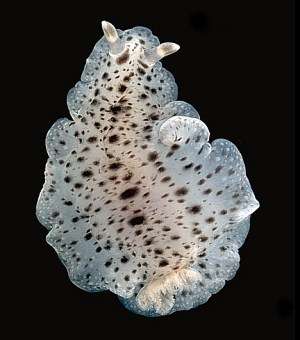

Dendrodoris elongata
Baba, 1936
Order: NUDIBRANCHIA
Suborder: DORIDINA
Family: Dendrodorididae
DISTRIBUTION
Tropical Indo-West Pacific.
PHOTO
UPPER: Adult, with characteristic mottled colour pattern. Animal fully extended in leech-like behaviour. LOWER: Juvenile animal with brown spotted colour pattern. Noumea, New Caledonia, October 1988. PHOTOS: Bill Rudman.
The animal characteristically elongates by forming the posterior end of the foot into a temporary sucker, and then greatly extends the anterior end, much like a leech or the aplysiid Dolabrifera dolabrifera. The edge of the mantle can be very thin and folded and the gill pocket is placed much nearer the posterior end of the bady than is normal in cryptobranch dorids. In juveniles the dark spots are much more clearly defined, while in larger specimens, the background colour becomes a more translucent grey, and the spots, which are sometimes linked, are a lighter brown and more diffuse. As I mention under Dendrodoris albobrunnea, there are earlier names for both these species.
Reference:
• Baba, K. (1936). Opisthobranchia of the Ryukyu (Okinawa) Islands. Journal of the Department of Agriculture, Kyushu Imperial University, 5(1): 1-50, Pl. 1-3.
Rudman, W.B., 1999 (April 18) Dendrodoris elongata Baba, 1936. [In] Sea Slug Forum. Australian Museum, Sydney. Available from http://www.seaslugforum.net/find/dendelon
Related messages
Re: Dendrodoris sp. from Northern Marianas Ids
August 15, 2007
From: Ali Hermosillo
Concerning message #19938:
Dear Bill and Harry,
I am pretty sure your Dendrodoris is D. albobrunnea. I have seen color variations from almost white to a very dark brown. The star-like white spots are always there.
Kind regards,
Ali
gueri25@hotmail.com
Hermosillo, A., 2007 (Aug 15) Re: Dendrodoris sp. from Northern Marianas Ids. [Message in] Sea Slug Forum. Australian Museum, Sydney. Available from http://www.seaslugforum.net/find/20167
Dear Ali,
I am pretty sure the whitish 'marks' are compound papillae which puzzles me. I have looked carefully at the photo from the top of the Fact Sheet and included a close-up alongside of the large star-shaped patches you describe. They are slightly raised, so it is perhaps possible that they are retractile compound papillae, but I find it strange I have never noticed them out before as I often have animals in aquaria for some time after collection. I would love a few photos of this from the Eastern Pacific if you have any.
Concerning what to call it. I wouldn't advise using the name Dendrodoris albobrunnea Allan, 1933 because I am not sure if it is identifiable. Certainly there is nothing characteristic in Allan's published description. Joyce Allan worked at the Australian Museum and I have checked out her collections but there is no sign of the holotype of this species or any notes or drawings. It is possibly te same as Baba's Dendrodoris elongata, but who knows? I think the only sensible thing to do is consider Allan's name to be unidentifiable and use the first identifiable name, which is Baba's.
Best wishes,
Bill Rudman
Dendrodoris sp. from Northern Marianas Ids
July 5, 2007
From: Harry Blalock

Hi Bill,
I recently sent you an e-mail about Halgerda guahan and Halgerda malesso. I have a few others that I have taken pictures of that I haven't been able to id up to now. Thanks for your help on these.
Locality: Lau Lau Bay, 60', Saipan, Northern Mariana Islands, Pacific, under rocks and on rubble. Length: 1-2". Photographer: Harry Blalock.
Sincerely,
Harry Blalock
harryblalock@gmail.com
Blalock, H., 2007 (Jul 5) Dendrodoris sp. from Northern Marianas Ids. [Message in] Sea Slug Forum. Australian Museum, Sydney. Available from http://www.seaslugforum.net/find/19938
Dear Harry,
I am in the process of cleaning out the backlog of messages so to save time I have not prepared the images of the two other species you had on this message. They were both flatworms. This animal though is very interesting as I am sure it is a species of Dendrodoris and it looks as though it is a species like D. elongata which, as its name suggests, can greatly elongate as it stretches out in a leech-like form of locomotion. When I first saw your photo I thought it had a series of pale star-shaped patches on the mantle but on closer examination they appear to be branching papillae. Another species with leech-like locomotion is the sea hare Dolabrifera dolabrifera, which also has branching papillae. I guess its going too far to suggest these two species are mimicking each other but it is quite a coincidence.
At this stage I am not sure if your animal is just a form of D. elongata or a separate species. If it is a separate species I am not sure if it has a name. I certainly can't recall a species with branched papillae like this
Best wishes,
Bill Rudman
First sea slug from the Galathea 3 Expedition
December 21, 2006
From: Kathe R. Jensen

Dear Bill,
I am presently on board the Danish naval vessel "Vædderen" (The Ram), which has been fitted as a research vessel hosting the Galathea 3 Expedition. We are a group of 16 people from the Zoological Museum in Copenhagen participating in the "leg" from Sydney to Gizo in the Solomon Islands. I was a little worried that maybe I wouldn't be able to earn my keep on this part of the expedition, but in the very first sample we took, I found this nudibranch, which I have tentatively identified as Dendrodoris elongata. It was collected in a triangular dredge from coral sand at about 60m's depth. It is very difficult to take pictures of small animals on a moving ship, but I hope that you can confirm (or change) my ID.
Locality: Off North Cay (southern end of the Great Barrier Reef), approx. 60 m, Australia, Coral Sea, 17 December 2006, dredged with triangular dredge. Length: 25-30 mm. Photographer: Kathe Jensen.
Best wishes,
Kathe
krjensen@snm.ku.dk


Dear Kathe,
I am happy to confirm your identification. IN your photo showing the underside of the head [lower left] you can see the 'headless' appearance at the front of the body between the foot and the mantle, where there is no 'snout' and no obvious head tentacles. I wish you luck on the expedition and hope it makes as many interesting discoveries as the famous first Galathea expedition
Best wishes,
Bill Rudman
Dendrodoris elongata from Eilat, Red Sea
January 28, 2005
From: Jacob Dafni

In the Coral World Park aquaria at Eilat very often nudibranch larvae enter with the sea water influx. Lately I found and took pictures of a small unknown Pleurobranchus crawling among coral debris. It does not fit other species recorded from our region. Could you determine its identity?
Locality: Eilat, Gulf of Aqaba. Israel. Red Sea
Length: ca. 7 cm. 14 January 2005
Photographer: Dr. Jacob Dafni
Jacob Dafni
jdafni@netvision.net.il
Dafni, J., 2005 (Jan 28) Dendrodoris elongata from Eilat, Red Sea. [Message in] Sea Slug Forum. Australian Museum, Sydney. Available from http://www.seaslugforum.net/find/12945Dear Jacob,
Although its gills are retracted this is a dorid, not a pleurobranch. It is a brownish form of Dendrodoris elongata. I am not sure of this species life history. It's possible it came into the aquarium as a larva, but its also possible it was carried in, hidden in a crack or hole in a piece of coral rock.
Best wishes,
Bill Rudman
Re: Dendrodoris elongata in aquaria
July 19, 2004
From: Christian Feiland
Dear Bill,
Thanks a lot for your help [m12475]. Unfortunately the slug seems to "shrink". I assume the slug has not found the right sponge in my Aquarium so far...
Regards from Istanbul,
Chris
chris@feiland.com
Feiland, C., 2004 (Jul 19) Re: Dendrodoris elongata in aquaria. [Message in] Sea Slug Forum. Australian Museum, Sydney. Available from http://www.seaslugforum.net/find/12621Dendrodoris elongata in aquaria
March 18, 2004
From: Christian Feiland

I found this in my 240l Seawater aquarium. The live rocks are from the Sea of Marmara (Mediterranean Sea - Turkey)
But I do have rocks from Singapore in my aquarium too. So, I am not sure where the slug is from.
Thanks a lot for your help!
Christian Feiland
chris@feiland.com
Feiland, C., 2004 (Mar 18) Dendrodoris elongata in aquaria. [Message in] Sea Slug Forum. Australian Museum, Sydney. Available from http://www.seaslugforum.net/find/12475Dear Christian,
This is almost certainly Dendrodoris elongata which is a species from the Indo-West Pacific. The most likely way it got in your aquarium was as a juvenile, hidden in some crevice in your live rock from Singapore. I assume there was some suitable sponge on the rock which has allowed it to feed and grow to its present size. The other alternative is that it, or its parents, came as a larvae from the Red Sea via the Suez Canal [see page on Lessepsian migrants] and settled on a rock in the Sea of Marmara.
Best wishes
Bill Rudman
Dendrodoris elongata from Fiji
October 17, 2001
From: Daniel Geiger

Hi Bill
I have no idea what that is beyond "dorid", Fiji, Nandi, First Landing, Sept. 13 2001.
Daniel.
dgeiger@nhm.org
Geiger, D., 2001 (Oct 17) Dendrodoris elongata from Fiji. [Message in] Sea Slug Forum. Australian Museum, Sydney. Available from http://www.seaslugforum.net/find/5439Dear Daniel,
This is what I am calling Dendrodoris elongata at present.
Best wishes,
Bill Rudman
